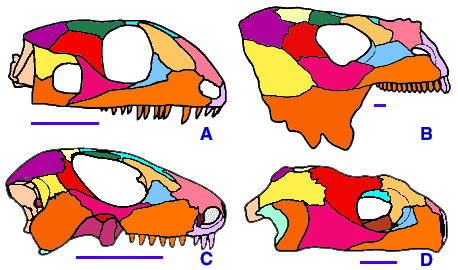







Most anapsids lack the lateral temporal fenestrae (openings in the side of the skull) characteristic of all other extant and most (but not all) other extinct amniotes. Indeed, Anapsida was named for this lack of fenestration. However, a few anapsids, such as lanthanosuchids, Acleistorhinus, and some millerettids had a large lateral temporal fenestra that gave them a superficial resemblance to synapsids (mammals and their extinct relatives).
The trait of temporal fenestration has been used extensively in phylogenetic studies of amniotes, but unfortunately, it is not a reliable guide to their evolution. For instance, the lack of a temporal fenestra in most anapsids is not a synapomorphy (shared derived characteristic) of this group because this condition is primitive for amniotes. In other words, not all extinct amniotes retaining an unfenestrated skull belong to Anapsida. For example, the oldest known relatives of diapsids (captorhinids and "protorothyridids") had unfenestrated skulls. See the page Temporal Fenestration and the Classification of Amniotes in the Tree of Life for a more extensive discussion of this topic.

Various Anapsid skulls: A, the Lower Permian genus Acleistorhinus. B, the pareiasaur Scutosaurus. C, the Triassic procolophonoid Procolophon. D. Proganochelys, the oldest known turtle. Scale bars equal 1 cm.
The large post-temporal fenestrae (large holes in the back of the skull) of turtles allow the jaw musculature to expand beyond the confines of the adductor chamber. This expansion allows the jaw musculature to be stronger and also permits a wider gape (in other amniotes, the lateral temporal fenestrae perform a similar function). The presence of large post-temporal fenestrae in procolophonoids and pareiasaurs suggests that the expansion of the jaw musculature of anapsids began as early as the Upper Permian.
Turtles have a tympanum that allows them to hear high frequency airborne sounds. Their tympanum is not homologous with the tympanum of mammals and saurians (extant diapsids) because it developed independently in all three groups. The tympanum of turtles is supported by a deep quadrate emargination, and the stapes of turtles is slender because it must vibrate quickly to transmit the sounds from the tympanum to the middle ear. The amniote quadrate primitively lacked an emargination (its posterior edge was more or less rectilinear) and the stapes was a robust bone that braced the braincase against the quadrate. Therefore, the earliest amniotes could not hear high frequency airborne sounds, but they could probably detect seismic vibrations (sounds transmitted through the ground). The presence of a quadrate emargination and a slender stapes in procolophonoids indicates that the tympanum appeared fairly early in the evolution of anapsids (by the Upper Permian).


